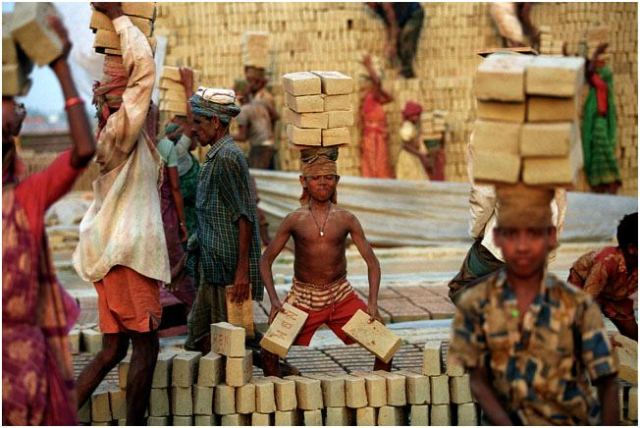Out of school children comprise the workers and non workers. In our view they together signify a measure of deprivation among children and can be considered as a potential labour pool always being at the risk of entering the labour force” – NCEUS, 2007India is sadly the home to the largest number of child labourers in the world. The census found an increase in the number of child labourers from 11.28 million in 1991 to 12.59 million in 2001. M.V. Foundation in Andhra Pradesh found nearly 400,000 children, mostly girls between seven and 14 years of age, toiling for 14-16 hours a day in cottonseed production across the country of which 90% are employed in Andhra Pradesh.40% of the labour in a precious stone cutting sector is children. NGOs have discovered the use of child labourers in mining industry in Bellary District in Karnataka in spite of a harsh ban on the same. In urban areas there is a high employment of children in the zari and embroidery industry.
Poverty and lack of social security are the main causes of child labour. The increasing gap between the rich and the poor, privatization of basic services and the neo-liberal economic policies are causes major sections of the population out of employment and without basic needs. This adversely affects children more than any other group. Entry of multi-national corporations into industry without proper mechanisms to hold them accountable has lead to the use of child labour. Lack of quality universal education has also contributed to children dropping out of school and entering the labour force. A major concern is that the actual number of child labourers goes un-detected. Laws that are meant to protect children from hazardous labour are ineffective and not implemented correctly.
A growing phenomenon is using children as domestic workers in urban areas. The conditions in which children work is completely unregulated and they are often made to work without food, and very low wages, resembling situations of slavery. There are cases of physical, sexual and emotional abuse of child domestic workers. The argument for domestic work is often that families have placed their children in these homes for care and employment. There has been a recent notification by the Ministry of Labourmaking child domestic work as well as employment of children in dhabas, tea stalls and restaurants “hazardous” occupations.
According to HAQ: Centre for child rights, child labour is highest among schedules tribes, Muslims, schedule castes and OBC children. The persistence of child labour is due to the inefficiency of the law, administrative system and because it benefits employers who can reduce general wage levels. HAQ argues that distinguishing between hazardous and non hazardous employment is counter-productive to the elimination of child labour. Various growing concerns have pushed children out of school and into employment such as forced displacement due to development projects, Special Economic Zones; loss of jobs of parents in a slowdown, farmers’ suicide; armed conflict and high costs of health care. Girl children are often used in domestic labour within their own homes. There is a lack of political will to actually see to the complete ban of child labour.
Bonded child labour is a hidden phenomenon as a majority of them are found in the informal sector. Bonded labour means the employment of a person against a loan or debt or social obligation by the family of the child or the family as a whole. It is a form of slavery. Children who are bonded with their family or inherit a debt from their parents are often found in agricultural sector or assisting their families in brick kilns, and stone quarries. Individual pledging of children is a growing occurrence that usually leads to trafficking of children to urban areas for employment and have children working in small production houses versus factories. Bonded labourers in India are mostly migrant workers, which opens them up to more exploitation. Also they mostly come from low caste groups such as dalits or marginalised tribal groups. Bonded child labourers are at very high risk for physical and sexual abuse and neglect sometimes leading to death. They often are psychologically and mentally disturbed and have not learnt many social skills or survival skills.
In 2000 the ILO estimated 5.5 million children had been forced in labour in Asia, while the Bonded Labour Liberation Front placed 10 million bonded children in India alone. In 1998 the government of India labelled bonded child labour as a marginal problem with only 3000 or so cases. A survey in Tamil Nadu in 1995 found 125,000 bonded child labourers in the state alone. Child bonded labour in India is mostly in the agricultural sector but has in recent times been moving into other sectors as well such as beedi-rolling, brick kilns, carpet weaving, commercial sexual exploitation, construction, fireworks and matches factories, hotels, hybrid cottonseed production, leather, mines, quarries, silk, synthetic gems, etc.
WRITTEN BY Naseema Rawther
PUBLISHED BY JASNEET SETHI





60 Comments